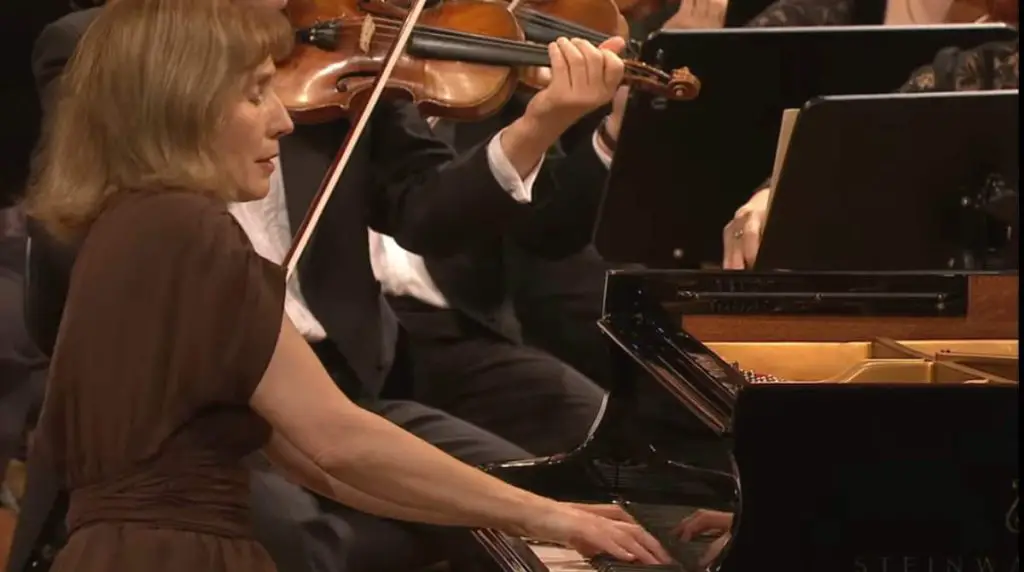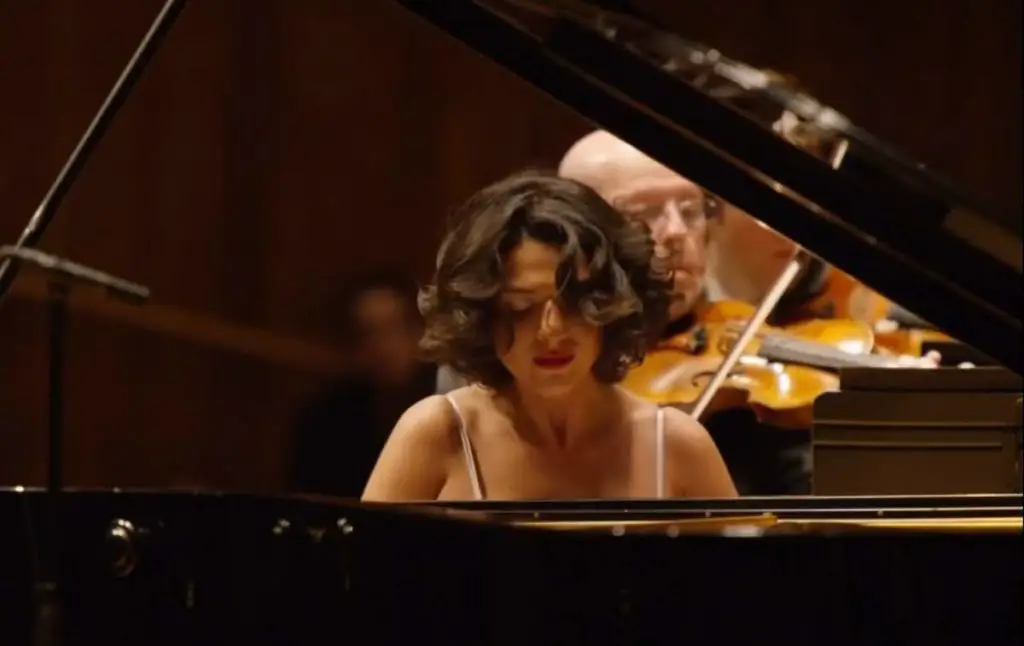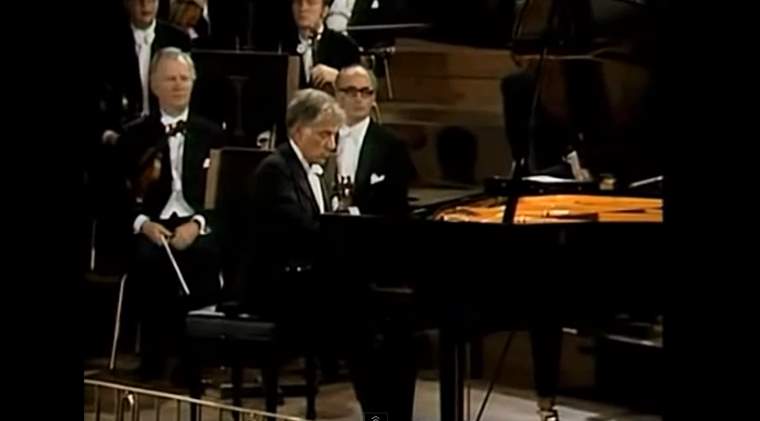Accompanied by the Polish-based early music orchestra {oh!} Orkiestra Historyczna, the legendary Argentine pianist Martha Argerich performs Ludwig van Beethoven’s Piano Concerto No. 1 in C major, Op. 15. Conductor: Václav Luks. Both the orchestra and Argerich play on period instruments. Argerich plays on an Erard grand piano built in 1858. The Erard firm was founded by Sébastien Erard (1752-1831), the French instrument maker of German origin. This performance was recorded during the opening concert of the 2nd International Chopin Competition on Period Instruments at the Concert Hall of the Warsaw Philharmonic on October 5, 2023.
Ludwig van Beethoven’s Piano Concerto No. 1
Ludwig van Beethoven’s Piano Concerto No. 1 in C major, Op. 15, is a work that showcases the composer’s mastery in bridging the Classical and Romantic eras of music. Despite its numbering as the first, it was actually composed after what is known as the Second Piano Concerto. Completed in its first version in 1795, when Beethoven was in his mid-twenties, the concerto was revised for its publication in 1801.
The concerto reflects Beethoven’s deep understanding and respect for the Classical traditions epitomized by Mozart and Haydn, while also infusing the work with his own distinctive style and innovative spirit. This concerto is notable for its grand scale, a characteristic that Beethoven would become renowned for in his later works.
From the outset, Piano Concerto No. 1 demonstrates Beethoven’s unique approach to the concerto form. The orchestration is rich and full, with Beethoven using the orchestra not just as an accompaniment to the piano but as an equal partner in the musical dialogue. This treatment of the orchestra is more symphonic in nature than what was typically found in concertos of the time, hinting at the larger, more dramatic style Beethoven would develop in his later works.
The piano part itself is both virtuosic and expressive, offering the soloist ample opportunity to showcase technical prowess and emotional depth. Beethoven’s own skills as a pianist are evident in the demanding solo passages, which require a high level of technical skill and musicality. The concerto also reflects Beethoven’s innovation in piano composition, with its use of a wider range and more varied dynamics than was typical of the period.
Harmonically, the concerto is adventurous for its time, with Beethoven exploring a range of keys and using modulation to heighten the dramatic effect. The structure of the concerto, while adhering to the traditional fast-slow-fast format, is expanded and developed with a freedom and scale that surpasses his Classical predecessors.
Thematically, the concerto is rich and varied, with Beethoven weaving a tapestry of melodies and motifs throughout the work. The themes are not only memorable but are developed and transformed in a way that keeps the listener engaged and anticipates the more complex thematic development Beethoven would employ in his later compositions.
The Piano Concerto No. 1 is both a tribute to the Classical concerto form and a bold statement of Beethoven’s emerging individual style. It balances Classical elegance and formality with Romantic expressiveness and innovation, making it a pivotal work in the piano concerto repertoire.
Movements
With start times in the video:
- 00:54 – Allegro con brío
- 15:09 – Largo
- 25:37 – Rondo. Allegro – Scherzando
1. Allegro con brío
The first movement of Beethoven’s Piano Concerto No. 1 in C major, Op. 15, marked Allegro con brio, is a dynamic and expansive piece that sets the tone for the entire concerto. This movement is a brilliant example of Beethoven’s early style, where he adheres to classical traditions while infusing his own innovative spirit.
Opening with a lengthy orchestral introduction, this movement immediately establishes a grand and majestic character. The orchestra introduces the primary themes, which are later taken up and elaborated by the piano. This introduction is characteristic of the concerto form as developed by Mozart, but Beethoven extends it, showcasing his symphonic approach and providing a rich tapestry of themes and motifs.
When the piano enters, it does so with a flourish, launching into a virtuosic display that interweaves the thematic material introduced by the orchestra. The piano’s entrance is a dramatic moment, highlighting the soloist’s role as both a collaborator and a leader in the musical dialogue. Beethoven’s writing for the piano is both technically challenging and expressively rich, demanding a high degree of skill from the performer.
The development section of the movement is where Beethoven’s creativity shines. He manipulates and develops the themes introduced in the exposition, taking the listener through various keys and exploring a range of harmonic and rhythmic variations. This section is marked by dynamic contrasts and a sense of drama, illustrating Beethoven’s mastery in building musical tension and release.
One of the unique aspects of this movement is its cadenza. Traditionally, concertos included a cadenza where the soloist could showcase their technical skill and improvisatory abilities. Beethoven, an accomplished pianist himself, wrote his own cadenzas for this concerto, which are considered an integral part of the piece. The cadenza in the first movement is particularly notable for its length and complexity, serving as a highlight of the soloist’s virtuosity.
The recapitulation brings back the main themes, now altered to fit the tonic key, and leads to a spirited conclusion. This section maintains the energy and dynamism of the rest of the movement, culminating in a triumphant and satisfying close.
2. Largo
The second movement of Beethoven’s Piano Concerto No. 1 in C major, Op. 15, is a sublime and expressive Largo that provides a striking contrast to the energetic and dynamic first movement. This movement is a beautiful example of Beethoven’s lyrical and introspective compositional style, showcasing his ability to create deeply emotional and contemplative music.
Marked Largo, the movement unfolds at a slow, expansive tempo, allowing for a full exploration of its emotional depth. The movement opens with a serene and delicate theme introduced by the orchestra, setting a mood of introspection and calm. This theme is characterized by its lyrical quality and gentle expressiveness, featuring a tender melody that is both simple and profound.
When the piano enters, it takes up the theme and elaborates on it, adding its own nuances and depth. Beethoven’s writing for the piano in this movement is notable for its expressiveness and sensitivity. The piano lines are often embellished with delicate ornamentations, adding to the movement’s intimate and reflective character.
Throughout the Largo, there is a dialogue between the piano and the orchestra, with each contributing to the movement’s overall sense of tranquility and introspection. The orchestration is subtle and restrained, providing a soft, supportive backdrop to the piano’s melodic lines. This interplay creates a rich, textured soundscape that is both soothing and emotionally resonant.
Harmonically, the movement is complex and rich. Beethoven uses a variety of chords and progressions to create a sense of depth and subtlety. The harmonic language contributes to the movement’s introspective mood, with moments of tension and resolution that add to its emotional impact.
One of the most striking features of this Largo is its sense of spaciousness and timelessness. Beethoven allows the music to breathe, with lingering chords and pauses that give the listener space to reflect and absorb the music’s beauty. The tempo and pacing of the movement are masterfully controlled, creating an atmosphere of serene contemplation.
The movement concludes gently and peacefully, fading away into silence. This conclusion is reflective and subdued, leaving the listener with a sense of calm and introspective closure.

3. Rondo. Allegro – Scherzando
The third and final movement of Beethoven’s Piano Concerto No. 1 in C major, Op. 15, is a vivacious and spirited Rondo marked Allegro scherzando. This movement is characterized by its lively tempo, playful character, and the brilliant interplay between the piano and the orchestra, bringing the concerto to a joyous and energetic conclusion.
The Rondo form, typically used by Beethoven in the final movements of his concertos, involves the repetition of a main theme (the ‘refrain’) interspersed with contrasting sections (the ‘episodes’). In this movement, the main theme is a catchy and rhythmic melody that is both lively and buoyant. This theme is introduced by the orchestra and then taken up by the piano, setting the tone for a movement full of vitality and cheer.
Beethoven’s writing for the piano in this movement is particularly noteworthy for its virtuosity and brilliance. The piano part is full of rapid scales, trills, and playful ornamentations that showcase the soloist’s technical skills and musicality. The piano often engages in a lively dialogue with the orchestra, creating a sense of dynamism and excitement.
The contrasting episodes in the Rondo bring variety and contrast to the movement. These sections explore different moods and keys, providing a rich tapestry of musical ideas and themes. Beethoven’s skill in developing these contrasting sections while maintaining cohesion with the main theme is a testament to his compositional mastery.
The orchestration in the third movement is vibrant and colorful, with Beethoven using the full range of the orchestra to complement and contrast the piano. The interplay between the soloist and the orchestra is one of the highlights of this movement, with each enhancing and responding to the other’s musical ideas.
Harmonically, the movement is adventurous and playful. Beethoven uses a variety of harmonic progressions and modulations to add interest and surprise, keeping the listener engaged throughout. The movement’s energetic rhythm and brisk tempo are maintained throughout, adding to its lively and spirited character.
The movement concludes with a spirited and jubilant finale, bringing the concerto to a triumphant and satisfying close. The final section of the Rondo is marked by a sense of exhilaration and joy, with the piano and orchestra coming together in a display of musical festivity.
Sources
- Piano Concerto No. 1 (Beethoven) on Wikipedia
- Piano Concerto No.1, Op.15 (Beethoven, Ludwig van) on the International Music Score Library Project website



